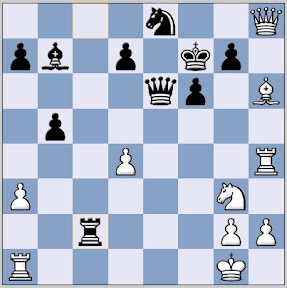1 d4 Nf6; 2 c4 e6; 3 Nc3 Bb4; 4 a3 Bxc3+; 5 bc
White essentially has one idea in mind: I'm going to blast open lines for my rooks and diagonals for my bishops, and checkmate you on the king-side. White often carries out this plan at any cost.
Strategically, it's easy to learn and I've enjoyed playing it; Such direct attacking has notched me some notable scalps. Of course, there is a downside, a well organised defence can expose the lack of flexibility and positional weaknesses (notably the c4 pawn) in White's position.
Over the coming weeks, I'll show you a few games in this line (wins for both Black and White) and some of my own personal favourites. To start with though, let's go back to Zurich 1953, and the second round encounter between Efim Geller and former World Champion Dr. Max Euwe. This game was awarded a brilliancy prize. The notes are abridged from David Bronstein's in his excellent book of the tournament:
Geller - Euwe, Zurich 1953
White initiates a powerful attack on the king by sacrificing his c4-pawn. This attack gave Geller every hope of success, provided Black held to the traditional sort of queen-side counterattack. Euwe, however, carried out two remarkable ideas: 1. Utilizing his queen-side lines of communication for an attack on the king's wing. 2. decoying the enemy's forces deep into his own rear area, with the aim of cutting them off from the defence of their king.
Watch White's pieces in their frontal assault on the king, burrowing further and further, while Black is transferring his forces by roundabout routes.
1 d4 Nf6; 2 c4 e6; 3 Nc3 Bb4; 4 e3 c5; 5 a3 Bxc3+; 6 bc b6; 7 Bd3 Bb7; 8 f3 Nc6; 9 Ne2 0-0; 10 0-0 Na5; 11 e4 Ne8
Black retreats his knight to forestall the pin with 12 Bg5, and to be able to answer f3-f4 with f7-f5, blockading the king's wing. White therefore secures f5 before advancing his f-pawn. It would be senseless to defend the c4 pawn now: that pawn was doomed by White's 5th move.
12 Ng3 cd; 13 cd Rc8; 14 f4 Nxc4; 15 f5 f6; 16 Rf4
White's attack has become rather threatening. Black's previous move was necessary to forestall White's intention to push his pawn to f6, and then, after 16 ... Nxf6, to the pin the knight after all, piling up on the king with the combined firepower of queen, rooks and three minor pieces. Even now, White needs only two moves to transfer his rook and queen to the h-file, and then it might appear that nothing could save the Black king. (it's a wonderful feeling as White to be able to 'thump-down' f5-f6 in this variation, we'll see some games later where this happens - RC)
16 ... b5!
The beginning of a remarkable plan. Clearly, any defensive manouevres on the king-side are fore-doomed, since they involve pieces with an inconsequential radius of activity (.. Rf7, .. Qe7, etc.). But Black does have another defensive resource, and that is counterattack! The bishop at b7, the rook at c8, and the knight at c4 are all well based; all that remains is to bring up the queen. The basis for this counteratack is Black's preponderance on the central squares. With 16 ... b5, Black reinforces the knight on c4 and opens a path for the queen to b6. Still, one cannot help feeling that his operations are too little and too late...
17 Rh4 Qb6
Pinning White's queen to the defence of the d-pawn, Black prevents the intended 18 Qh5. After 17 Qh5 Qb6; 18 Ne2 Ne5, we get the echo variation with the rook unable to get to h4.
18 e5 Nxe5; 19 fe Nxd3; 20 Qxd3 Qxe6; 21 Qxh7+ Kf7; 22 Bh6 Rh8
If Black's 16th move was the beginning of his strategic plan of counterattack, then this rook sacrifice is it's fundamental tactical stroke, with the aim of drawing the White queen still further afield and decoying it from the c2, meanwhile attacking the king.
23 Qxh8 Rc2
Threatening mates in a few moves: 24 ... Rxg2+, 25 ... Qc4+, etc. Detailed analysis requiring more than just one week's time, showed that White could have saved himself from mate by finding a few 'only' and very difficult moves. First, he has to play 24 d5; if then 24 ... Qb6+; 25 Kh1 Qf2; 26 Rg1 Bxd5, White saves himself with 27 Re4!; and on the immediate 24 ... Bxd5, not 25 Rd4 - only 25 Rd1! works: after 25 ... Rxg2+; 26 Kf1 gh, neither 27 Rxh6 nor 27 Rxd5: once again, the only move is 27 Qxh6. Black would still have bishop and two pawns for his rook then, which would leave him good winning chances.
24 Rc1 Rxg2+; 25 Kf1 Qb3; 26 Ke1 Qf3 0-1


No comments:
Post a Comment